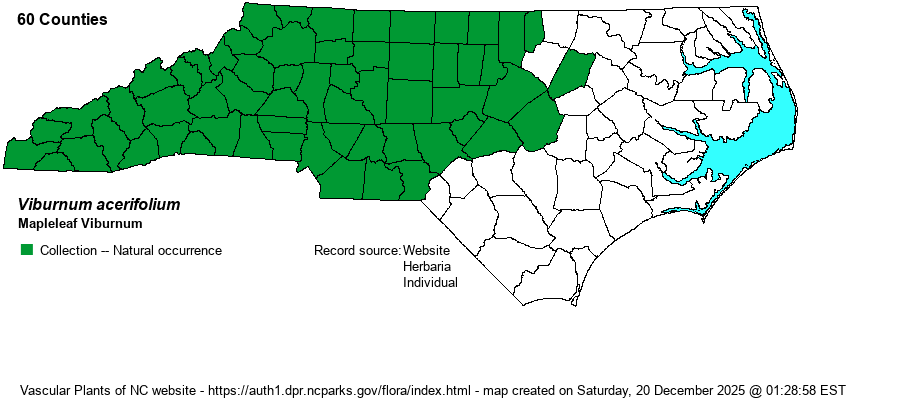| Author | L. | |
| Distribution | Throughout the Mountains and Piedmont, except possibly absent in the extreme northeastern corner; absent in the Coastal Plain.
This species has a wide range across most of the eastern U.S. and southern Canada, ranging south to the FL panhandle and eastern TX. However, it is generally absent from the Atlantic Coastal Plain.
| |
| Abundance | Common and widespread in the Mountains and the western and central Piedmont; fairly common to frequent in the eastern Piedmont, except rare to uncommon in the northeasternmost counties there. | |
| Habitat | This is a widespread species in dry to mesic upland forests, mostly under a hardwood or mixed canopy. It is more numerous on slopes and bluffs than on flats or gentle slopes; it can be common on rocky slopes. |
| Phenology | Blooms from late April to early June; fruits from August to October. | |
| Identification | This is a medium-sized, deciduous shrub that grows to about 3-4 feet tall. It has opposite, serrate, maple-like leaves (three distinct triangular lobes), reaching 3-4 inches long. Red Maple (Acer rubrum) also has opposite leaves, but the viburnum has rather wrinkled and less shiny leaves that do not have red petioles; the maple has a more jagged leaf margin as well. (Other maples have more entire leaves or more square-shaped lobes.) This species has typical viburnum flowers and fruit – a conspicuous, gently rounded and broad cluster of small white flowers at the branch tips, followed by black berries (drupes). Most observers have little trouble identifying this species owing to its waist-high growth and three-lobed leaves. | |
| Taxonomic Comments | Most references do not list varieties for this species. However, NatureServe lists two, for NC: the nominate var. acerifolium and var. glaucescens. This is probably not justified, especially as neither NatureServe nor NC NHP has provided any level of abundance for this latter variety, and Weakley (2018) does not include varieties.
| |
| Other Common Name(s) | Maple-leaved Viburnum, Dockmackie | |
| State Rank | S5 | |
| Global Rank | G5 | |
| State Status | | |
| US Status | | |
| USACE-agcp | FACU link |
| USACE-emp | UPL link |

